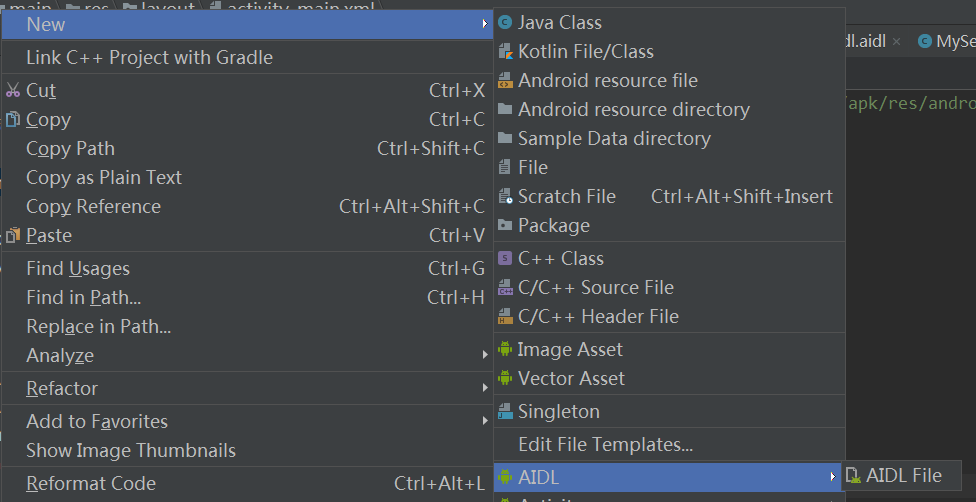想想工作都小半年了,对于这种机制还是似懂非懂,一直没用到过,也就一直不懂。
今天抽空研究一下,万事开头难,难者不会,会者不难!
算是一个比较难理解的概念了,Android的所谓AIDL 机制,一涉及都AIDL各种博客就开始说,需要懂Android中序列化,Android中Service,Binder,Messager等诸多理论,想想自己这些理论都没怎么掌握,看到这里就知难而退了,能不能少点套路,多点实际demo,一下子就能学会基本用法。因为对于不了解AIDL机制的同学们,你扯一大堆没用的,我们这种水平看完还是没用,直到我跑了一个demo,记录下全过程。
AIDL机制,说太多理论,不进行实际的操作还是不明白。进程间通信,那就让activity与Service之间通信试一试!
这里可能有些同学会有疑问,activity与service同样属于android4大组件之一,一般情况下一个Application只有一个进程,在一个应用内怎么可能涉及到远程通信呢?service 包括本地服务和远程服务,区别就在于是否属于同一个进程,通过属性值 android:process=“:remote” ,在AndroidManifest.xml文件中配置这一句话,就表示2者分属不同进程,是不是很简单。
<service android:name=".MyService" android:process=":remote"/>
MainActivity.java
package com.example.mytry; import android.app.Activity; import android.content.ComponentName; import android.content.Context; import android.content.Intent; import android.content.ServiceConnection; import android.os.Bundle; import android.os.IBinder; import android.os.RemoteException; import android.util.Log; import android.view.View; import android.widget.Button; public class MainActivity extends Activity implements View.OnClickListener { private Button button, button2; MyAidl aidlInterface; private ServiceConnection serviceConnection = new ServiceConnection() { @Override public void onServiceConnected(ComponentName name, IBinder service) { Log.i("liuting", "onServiceConnected: " + name.getClassName()); aidlInterface = MyAidl.Stub.asInterface(service); } @Override public void onServiceDisconnected(ComponentName name) { Log.i("liuting", "onServiceDisconnected: " + name.getClassName()); aidlInterface = null; } }; @Override public void onCreate(Bundle savedInstanceState) { super.onCreate(savedInstanceState); setContentView(R.layout.activity_main); button = (Button) findViewById(R.id.button); button2 = (Button) findViewById(R.id.button2); button.setOnClickListener(this); button2.setOnClickListener(this); } @Override public void onClick(View v) { if (v.getId() == R.id.button) { bind(); } else if (v.getId() == R.id.button2) { startMethod(); } } /** * 实现aidl中的方法 */ private void startMethod() { try { aidlInterface.basicTypes("我是信息dd:原来是我把信息传给服务的"); } catch (RemoteException e) { e.printStackTrace(); } } /** * 绑定到服务上去 */ private void bind() { Intent intent = new Intent(MainActivity.this, MyService.class); bindService(intent, serviceConnection, Context.BIND_AUTO_CREATE); } }
MyService.java
package com.example.mytry; import android.app.Service; import android.content.Intent; import android.os.IBinder; import android.os.RemoteException; import android.util.Log; import static android.content.ContentValues.TAG; public class MyService extends Service { public MyService() { } private final MyAidl.Stub mBinder =new MyAidl.Stub() { @Override public void basicTypes(String dd) throws RemoteException { Log.i("liuting_dd", "收到来自activity的信息: "+dd); } }; @Override public IBinder onBind(Intent intent) { // TODO: Return the communication channel to the service. return mBinder; } }
MyAidl.aidl
// MyAidl.aidl package com.example.mytry; // Declare any non-default types here with import statements interface MyAidl { /** * Demonstrates some basic types that you can use as parameters * and return values in AIDL. */ void basicTypes(String dd); }
activity_main.xml
<LinearLayout xmlns:android="http://schemas.android.com/apk/res/android" android:layout_width="match_parent" android:layout_height="match_parent"> <Button android:id="@+id/button" android:layout_width="wrap_content" android:layout_height="wrap_content" android:text="bindService" /> <Button android:id="@+id/button2" android:layout_width="wrap_content" android:layout_height="wrap_content" android:text="startMethod" /> </LinearLayout>
只要以上这几个文件就搞定了。5个文件demo就跑起来了。
aidl文件的创建不知道的看这里,知道的可以忽略。android studio中new 可以new出android中任何格式的文件。


就这样一个工具,之前看到的时候让我欣喜了好几天,android studio就是超级强大!
demo跑起来了,是否有些不理解!
——AIDL:Android Interface Definition Language,即Android接口定义语言。
详情见
https://developer.android.com/guide/components/aidl.html?hl=zh-cn






















 9382
9382











 被折叠的 条评论
为什么被折叠?
被折叠的 条评论
为什么被折叠?








